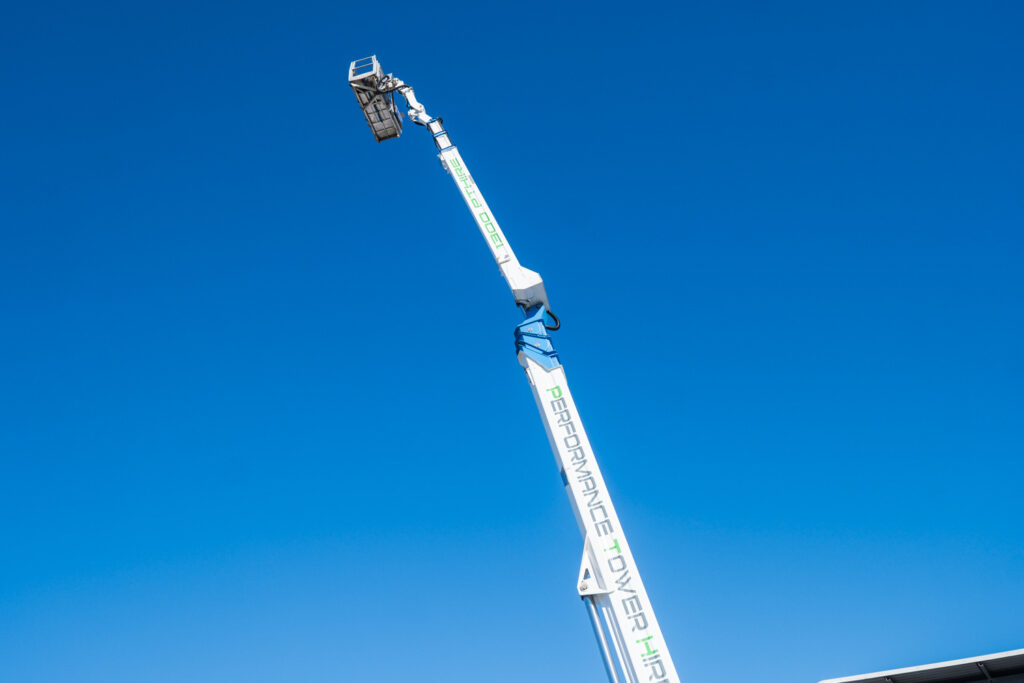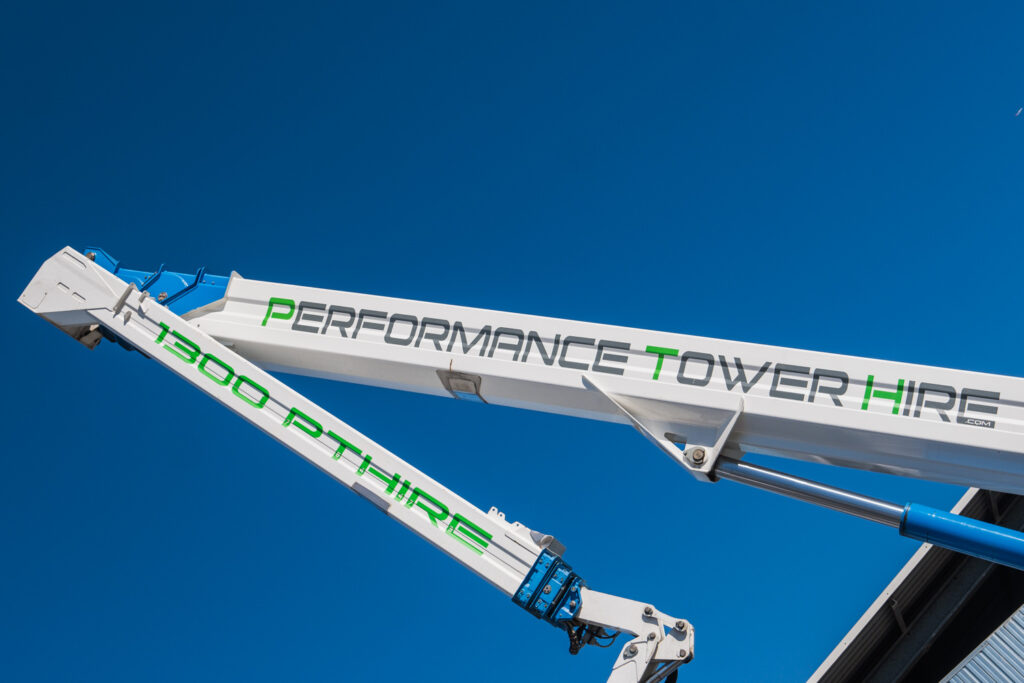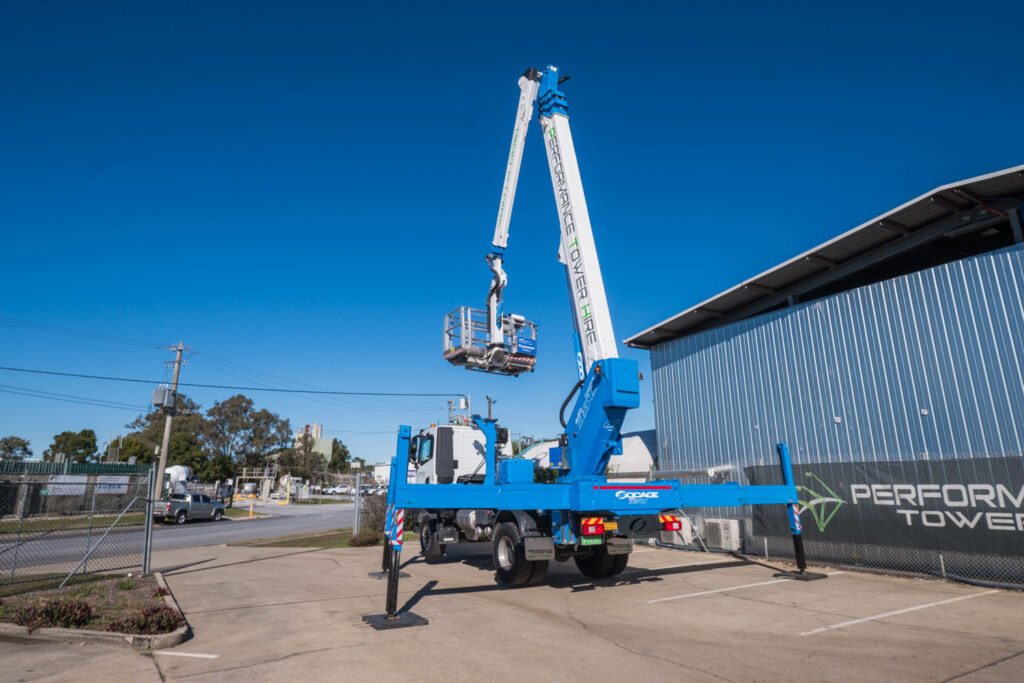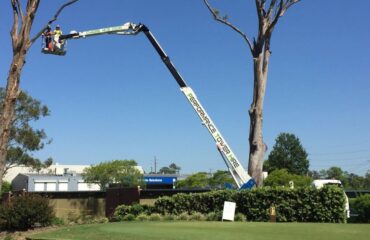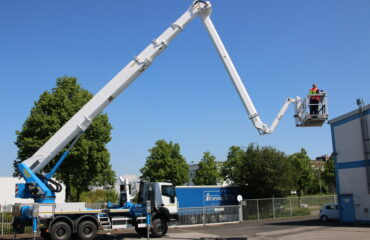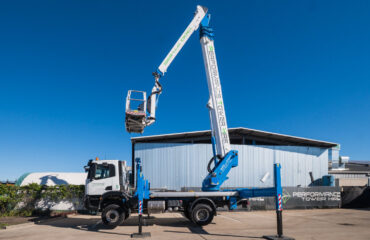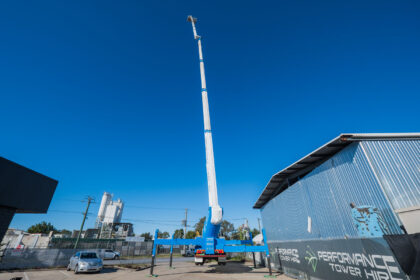
If you’ve ever worked at height, you know how fast a little slip-up can turn into something serious. This guide breaks down what you really need to know about how to be safe when using a cherry picker. These are simple, real-world tips that will make a difference.
Please note that this article is intended to give you a brief guide of the things you need to do and what you need to consider in order to be safe when using cherry pickers. It should not be used as a replacement to training or as an instruction manual for unlicensed operators.
Safety While Using Cherry Pickers
If you’re asking about ‘How to Be Safe When Using a Cherry Picker?’, start by spotting where most jobs go wrong and build your plan from there. Cherry pickers are incredibly useful, but there will always be risks when working at heights. Solid planning, the right gear, and a steady approach significantly reduce these.
Performance Tower Hire operates a safety-first setup with well-maintained truck-mounted EWPs ranging from 16 metres to 54 metres. Safety is paramount to us, so if you ever have any questions, please ask!
Use Only Licensed Operators
Safety when using a Cherry Picker begins with relying on competent operators. In Queensland, boom-type EWPs above 11 metres require a High Risk Work Licence. For smaller booms and scissor lifts, operators should have current competency for the class they’re using. If your crew is short on tickets, consider wet hire with a qualified operator to ensure the job gets carried out as it should.
Why proper training matters
Good training gives operators real-world skills and sharpens their eye for hazards. Someone who’s been properly trained knows how to read the ground, follow load limits without second-guessing and handle the controls. That improves your risk profile.
Using the Right Machinery
A big part of cherry picker safety is matching the machine to the job. Height, horizontal outreach, basket capacity, and access all matter. Pick a cherry picker that’s too small, and you’ll probably find yourself stretching further than you should. Go too big, and you might have trouble maneuvering into tight spots, not to mention paying extra for lift power you’ll never use.
For a quick guide to picking the correct height and outreach, see how high can a cherry picker reach?
Check Access Requirements
Part of cherry picker safety is establishing the work zone you will be operating in. Before the truck arrives, look at the approach route, gate widths, overhead branches, parked cars, and underground services. Confirm there’s enough firm, sufficiently stable ground for the cherry picker setup, and allow room for outriggers and stabilisers.
Plan traffic control if you’re on a busy street: post barriers and signage to keep the public out of your drop zone.
Conduct Risk Assessment
If you want ‘How to Be Safe When Using a Cherry Picker’ to be more than a slogan, write a risk list before the truck arrives. Walk the site and record your identified risks. Note overhead power lines, soft ground, nearby trenches, wind exposure, and weather. Identify rescue routes and a spot for a ground operator.
Go through the manufacturer’s manual and figure out the machine’s limits. Keep the weight of your operator plus their tools and materials well below it, leaving some room to spare.
Pre-Operation Inspection and Equipment Checks
A consistent pre-operation inspection is essential to being safe when using a cherry picker. A quick once-over isn’t enough – instead, run through a thorough pre-use checklist from top to bottom. Keep an eye out for things like hydraulic leaks, worn hoses, loose bolts, tyre damage, or any cracks in the welds.
Clean the platform floor, check your lanyard and boom lift harness anchorage, test the horn, and make sure you have radios. Test tilt alarm functionality. Make sure the emergency stop buttons actually work, and double-check the lowering procedure and any interlocks. You want to know all that stuff’s ready to go before you’re up in the air, not when you’re already in a sticky situation.
Small habits prevent big headaches. These steps all help avoid picker cherry accidents and maintain elevated work platform safety.
Wear your PPE
PPE is extremely important – trust us, this is for a reason. Strap on a full-body harness and clip it to the platform’s anchor point with a short lanyard, it’s there to keep you inside the rails. Throw on a hard hat, eye protection, gloves, and some solid boots with decent grip. And whatever you do, keep both feet planted on the deck.
Emergency Procedures
Know how to stop the cherry picker operations quickly and come to a safe stop. Locate the emergency stop buttons at the ground and platform controls. Run through the emergency lowering procedure with your team a couple of times. Hopefully you won’t need to implement them in a real life scenario, but if you do you’ll be glad you practiced them.
Ensure clear communications between the ground team and operators in the basket. Radios can prove invaluable here.
Have a rescue plan that covers a power failure, a medical event in the basket, and a machine fault. Put the plan in the site induction and brief everyone. These are the cherry picker emergency procedures that matter when it all goes wrong.
Environmental Awareness
Weather calls are a big part of being safe when using a cherry picker. Wind, rain, and lightning change your risk picture. If gusts pick up, stop and lower the platform. Avoid operating in storms or poor visibility. Before you set up, take a few minutes to clear out any debris, cover holes or pits, and get rid of anything that could trip someone up.
A tidy site isn’t just nice to look at, it seriously cuts down the chances of an accident and keeps your path clear for moving around safely.
Hire for the Right Amount of Time
Booking enough time when hiring a Cherry Picker removes time pressures. Short hire windows push crews to rush. Make sure there’s enough time for delivery, setup, a toolbox talk, and a steady pace on the tools. Chat to the PTH team about the job at hand and we’ll help guide you to the correct hire time. The right booking length reduces stress and cuts mistakes.
If you’re weighing up options, this guide to cherry picker hire cost in Brisbane will help you plan.
How to Ensure Complete Safety When Hiring a Cherry Picker
You want to go with the right hire company when it comes to cherry picker safety. At Performance Tower Hire, we live and breathe EWPs, so you know you’re getting a machine that has been impeccably maintained. You get modern, well-maintained machines, a friendly crew, and the flexibility to choose wet or dry hire. We’re on call 24/7, so you can speak with a real person and get the right machine moving quickly.
Performance Tower Hire is ready to help with fast advice, quality gear, and operators who care about doing it right.
Ready to book? View Cherry Picker Hire services for Brisbane and SE QLD.
Cherry Picker Safety FAQs
Why does the ground need to be level and solid?
If the ground isn’t firm and flat, the whole machine ends up rocking around and just doesn’t stay steady.
Why wear a harness and PPE every time?
Because if the basket jolts, that harness is what keeps you inside. And the basics, hard hat, eye protection, gloves, save you from grit in the eyes or stuff falling from above.
Why follow the manufacturer’s load limits?
Because those limits are about stability, not convenience. Overloading adds stress, reduces your safety margin, and can actually cause the platform to fail.
Why should emergency rescue procedures be in place?
Because if something happens, seconds matter. A team that’s practiced knows exactly how to get the basket down fast and help whoever’s inside.
Why keep an eye on the weather?
Because wind, rain, or lightning can completely change how the machine handles. If you’re watching the weather, you can call a pause before it becomes dangerous.
Why clear the site of obstacles and debris first?
Because loose gear and rubble are just accidents waiting to happen. A tidy site makes it easier to move safely and keeps everyone out of the drop zone.
Why not leave the cherry picker unattended while it’s raised?
Because people can wander underneath or accidentally knock the controls. Bringing it down during breaks keeps those surprises from happening.


